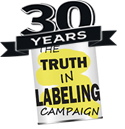LABEL LIES
Basic Facts (things the "glutes" don't want you to know)
This is How the "MSG is Safe" Game is Played
Propaganda
 Things The "Glutes" Don't Want You to Know
Things The "Glutes" Don't Want You to Know
The reaction to MSG (which is actually a reaction to the free glutamate in MSG) is a reaction to a toxic substance (i.e., a poison). It is not an allergic reaction.
Allergy tests may be helpful in identifying allergic reactions. But allergy tests tell nothing about sensitivities to toxic substances. The glutamate industry (Glutes') suggestion that "if you think you are reacting to MSG you should see an allergist" would seem to be purposely deceptive. The only way for a physician to confirm sensitivity to a toxic substance is to watch the patient ingest the toxic substance, and observe the adverse reaction.If a consumer ingests any processed free glutamic acid (MSG), he or she will be eating L-glutamic acid (L-glutamate) and D glutamic acid (D-glutamate) plus the additional impurities that are invariably produced with manufacture of glutamic acid.
When Ajinomoto tells you that the L-glutamate in unprocessed/ unadulterated/ unfermented protein is the same as the L-glutamate in MSG, they're spewing out propaganda -- not fact.L-glutamate found in unprocessed/unadulterated/unfermented protein is L-glutamate, only. Whereas MSG (and the free glutamate in MSG) used in cosmetics, drugs, vaccines, dietary supplements, and processed food is manufactured, and always contains L-glutamate plus D-glutamate (an unwanted byproduct of L-glutamate production) plus other unwanted by-products of production that industry calls impurities. And since industry has not found a way to remove the unwanted impurities from processed free L-glutamate, the L-glutamate used in cosmetics, drugs, vaccines, dietary supplements, processed food – used anywhere -- always comes with impurities.
It is glutamic acid that has been manufactured that causes brain damage and adverse reactions. Glutamic acid found in unadulterated protein causes neither brain damage nor adverse reactions.
Glutamic acid found in protein is L-glutamic acid, only. Manufactured glutamic acid contains L-glutamic acid, but in addition to the L-glutamic acid that is derived from the protein source, manufactured glutamic acid contains a variety of impurities (unwanted by-products of production) that are inevitable results of manufacture. D-glutamic acid and pyroglutamic acid are two of those impurities.
Some of the impurities produced when acid hydrolysis is used to create MSG are carcinogenic.
Impurities vary depending on the way in which the processed free glutamic acid (MSG) was processed and the materials (food source, enzymes, bacteria, etc.) used in processing. But D-glutamic acid and pyroglutamic acid are always among the impurities. Impurities produced when acid hydrolysis is used to create MSG include carcinogenic mono and dichloro propanols. Acid hydrolysis is the most common method of hydrolyzing protein in the United States.MSG and free glutamate can enter the body through the mouth, through the nose, and through the skin. MSG and free glutamate can enter the brain through the blood brain barrier, which is often incomplete through childhood, never intact in certain regions of the hypothalamus, and is easily damaged by things like high fever, seizures, stroke, and the normal process of aging. MSG and free glutamate ingested by a pregnant female can also cross the placental barrier.
Production and distribution of the monosodium glutamate used extensively in the United States today began in/or about 1957. It is a fermentation process in which specially selected strains of genetically modified bacteria excrete glutamic acid through their cell walls.
In 1956, the Japanese succeeded in producing glutamic acid by means of bacterial fermentation; and after considerable research to identify suitable strains of microorganisms for starting the requisite cultures, large-scale production of glutamic acid and monosodium glutamate through fermentation began. In this fermentation process, genetically modified bacteria are grown aerobically in a liquid nutrient medium. These bacteria have the ability to synthesize glutamic acid outside of their cell membranes and excrete it into the medium to accumulate there.There is a difference between real food that is high in glutamate, and processed food that contains MSG. Real food (unprocessed, unadulterated, unfermented food), no matter how much glutamate it contains, will not cause adverse reactions even in MSG-sensitive people. Food that contains MSG will cause MSG-reactions in MSG-sensitive people if the amounts ingested exceed those persons’ tolerances for MSG.
A significant element in the Glutes’ global propaganda scheme is to suggest that if people were sensitive to MSG, they would also be sensitive to L-glutamate in real food. It is to forward that "spin" that the glutes produce charts detailing the amount of glutamic acid in a variety of foods. "Consumer Confusion" is the name of the game being played here.The "scientific authorities” from around the world often cited by the Glutes -- including The Federation of American Societies for Experimental Biology (FASEB), the United Nations World Health Organization/Food and Agriculture Organization's Joint Expert Committee on Food Additives (JECFA), the European Communities' (EC) Scientific Committee for Food, and the Council on Scientific Affairs of the American Medical Association (AMA) -- have, for all intents and purposes, agreed that MSG is "safe." Each of these organizations, with minor exception, has considered only those documents submitted to them by Ajinomoto’s International Glutamate Technical Committee (IGTC) or their agents, or their glutamate-industry friends at the FDA.
Research having to do with the "safety" of MSG, designed and implemented by IGTC and/or other agents of the glutamate industry, is flawed to the point of being fraudulent. Use of placebos that contain excitotoxic amino acids which cause reactions identical to those caused by the excitotoxic free glutamate in MSG test material is an example.
MSG fed to very young laboratory animals, kills brain cells in the area of the hypothalamus, and, through that damage, causes a number of endocrine disorders. One of those endocrine disorders is gross obesity. Another is infertility.
Certainly, overeating and failure to exercise may contribute to obesity. But if you were exposed to MSG through your mother's diet when she was pregnant or nursing, or through the MSG in infant formula and/or vaccines; and if the area of your hypothalamus that should have controlled overeating had been damaged or destroyed by MSG (which we know can happen), you would have great difficulty controlling overeating -- and no amount of exercise would overcome your disadvantage.
The FDA works actively with the glutamate industry, often, but not always, through the IGTC, to maintain the myth that use of MSG poses no risk to humans.
The greatest risk of brain lesions, endocrine disorders, and adverse reactions following ingestion of MSG is the risk to children (whose blood-brain barriers are not fully developed), and to the elderly (whose aging blood-brain barriers may be deteriorating).
Promoting MSG-containing infant formula, especially hypoallergenic formula, enteral feeding products, and dietary supplements such as Ensure and Boost for the very young and for the elderly is, in this author's view, unconscionable.
Many vaccines contain free glutamate.
Free glutamate has been used by some farmers as a plant growth enhancer and fertilizer, and has been sprayed on crops as they grew. To our knowledge, all such crops have been approved for such treatment by both the Environmental Protection Agency (EPA) and the California Department of Pesticide Regulation (CDPR).
MSG is hidden in and on unprocessed produce that has been treated with plant "growth enhancers," fertilizers, pesticides, and fungicides that contain MSG.Pharmaceutical companies are producing glutamate-blocking drugs to use against neurodegenerative diseases such as Alzheimer's disease.
By law, the burden of proof that any food ingredient is safe lies with the manufacturer. We know that the glutamate industry's alleged "proof" that MSG is safe is badly flawed.
The glutes control the media. Since "60 Minutes" did a segment on MSG in 1991, we have not seen one piece in major media that even comes close to questioning the "safety" of MSG.
The International Food Information Council (IFIC) is a public relations firm that represents various segments of the food industry. They have been representing the glutamate industry for many years. They are not an independent organization.

